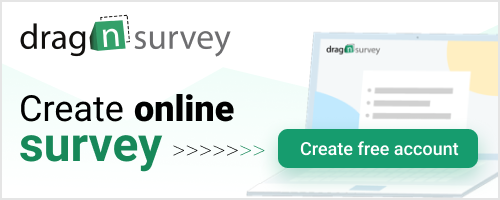Surveys are a great tool for all businesses. They can help you formulate future projects, collect feedback from customers and gauge the pulse of your employee’s job satisfaction. However, a survey is only as good as its questions. If you don’t have a good set of questions, or they are written poorly, then you can be sure that people won’t respond or the information on offer isn’t fit for purpose.
The point of the survey is to get as many people to respond to it as possible. The higher the engagement rate in the survey, the less people you have to invite to give responses to be sure of an unbiased data set.
So, here are some strategies for writing surveys that your audience will want to respond to and that will enable you to collect useful data for your research purposes.
>> Create your Online Poll with Drag’n Survey, click here

1. Be Clear, Specific And Direct
Asking a clear question is important in getting the right answer. Any kind of vagueness in your questions and you’ll end up confusing participants of your survey and get a wide range of answers which might not be compatible.
Take for example asking how often someone eats out. A vague way of asking this could be:
How often do you eat out?
This doesn’t give a time period or what counts as eating out. Does this include picking up a sandwich from a grocery store? Instead, a better way of asking this would be:
How often to you eat at a restaurant in a month?
Be clear with your questions and people will be able to answer them better. If they don’t understand they might leave it, or, even worse, give up on your survey.
2. Use Language Your Audience Will Use
Remember to use the language that your audience will be likely to use. If the audience can’t understand the question, they’ll leave the survey. To help you, consider abandoning jargon, abbreviations, acronyms and complex terms.
You should also never assume that the audience has specific knowledge. Some people can use equipment/services without ever knowing everything about the organization. Sometimes employees can work for years in a company without some specific knowledge.
Therefore, keep your questions short and simple, yet provide all the information that the audience needs to answer the question you’re asking.
If you do need to put in lots of information, in order for the audience to answer the question, separate the information. It makes it easier for the audience to spot what is key information and what the question is.
3. Mix Closed-Ended Questions With Open-Ended Questions
There are several reasons why you might want to mix together closed-ended questions with open-ended questions. Firstly, it breaks up the monotony of the questions, ensuring that audiences don’t get bored when filling out their answers, it also allows you to collect a wide variety of answers that can offer different results.
If you also ask the same query in two different ways, you can be sure that you get the information you want.
4. Ask Only One Question At A Time
Many surveys make a major mistake of asking lots of questions within one. For instance, they might ask this:
How often a week do you go to restaurants and how much do you spend?
Several aspects are wrong with this question. Firstly, the participants might not know which to answer first. Moreover, if someone goes two or three times a week to a restaurant, then do they tell you their weekly spending or the average cost of each restaurant trip? To avoid this, you really should be broken into two. For instance:
How often do you eat at a restaurant in a week?
And
How much do you spend on an average eating experience at a restaurant?
Another example of this could be:
Are you happy with your workload and compensation?
Instead, this question should be:
Are you happy with your workload?
And
Are you happy with your compensation?
5. Speak To Your Audience Like You’re Having A Conversation
Having a list of robotic style queries isn’t going to get a good response rate. Instead, you need to develop a relationship with the individuals responding to your survey. Therefore, start a conversation with them through your writing. Start with the introduction, for instance:
Hi there! Sorry to intrude, but would you mind answering some quick questions about your recent experiences? It will only take five minutes, I promise.
When you are forthcoming and friendly, you will do better in getting responses from your audience.
Conclusion
You need to make sure that the questions are written in a clear, concise manner that people will want to respond to. There are many aspects to writing questions and the strategies above will help you. Then you can be sure of collecting enough responses for a clear set of data.
More about surveys:
The Difference Between Survey And Questionnaire, click here
The Highest Rated 10 Tools for Online Form Mastery, click here
Key Tools to Develop a Customer Satisfaction Survey, click here
Want Your Survey Answered? Don’t Use These Questions, click here
7 Online Survey Templates to Captivate Your Students Instantly, click here
Turn Your Customer Feedback Into Stunning Marketing Content, click here
Tired Of Employees Not Giving The Answers You Need – Carry Out A Survey, click here
Read the french version:
5 astuces pour créer un sondage qui donne envie de répondre, click here
